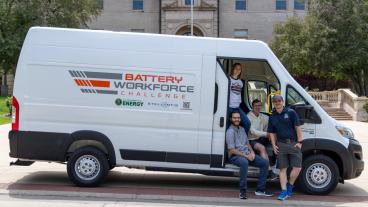3000-pound NASA balloon payload, prepared at Mines, now in shipment to New Zealand for launch

A specialized 3,000-pound payload that was integrated and tested at Colorado School of Mines is scheduled for launch in April or May from Wanaka, New Zealand on a NASA balloon to study the highest energy particles in the universe.
The Mines astroparticle team is central to the mission, with Lawrence Wiencke, professor of physics, serving as international deputy primary investigator and project manager for the Extreme Universe Space Observatory on a Super Pressure Balloon II (EUSO-SPB2).
“The complexity and scope of this mission is a good demonstration of the breadth of research going on in the Physics Department and at Mines as a whole,” Wiencke said. “Drawing on our experience from balloon flights in 2014 and 2017, Mines’ leadership in this particular mission really puts us on the map in research from sub-orbital altitudes.”
The Mines team has worked on the project in collaboration with 30 institutions from around the world over the past five years. The goal, Wienecke said, is to make the first measurement of high energy cosmic rays from suborbital altitude using optical techniques, something that has never been done before. Ultimately, EUSO-SPB2 is a pathfinder toward the creation of a satellite instrument that could view a huge area of atmosphere from the vantage point of space.
“We use the Earth’s atmosphere as a calorimeter to look at the highest energy particles in the universe,” said Wiencke.
The EUSO-SPB2 payload includes two one-meter diameter telescopes with wide field of view optics and specialized high-speed custom cameras systems.
“One telescope will point down to record fast streaks of UV scintillation light from high energy cosmic rays that interactions below the balloon,” Wiencke said. “We tried this in 2017, but that telescope didn’t catch any before a problem with the balloon forced an early termination. The collaboration has since developed a more sensitive 1-meter telescope with a much wider field of view, and we figured out a way to fit two of them into the mass budget that NASA can fly on this mission.”
Mines PhD student George Filippatos is leading the operations and data analysis groups for this instrument. Mines PhD student Viktoria Kungel let the effort to bond the mirror segments for both telescopes to meet the focusing requirements and also meet strict NASA safety requirements and characterize their properties.
The other telescope will point toward the Earth’s limb, or edge, as seen from the balloon. It will record extremely short flashes of beamed Cherenkov light from cosmic rays that interact in the atmosphere above the limb, another first. Searches for optical signatures of elusive sub-atomic particles called tau neutrinos that interact in the Earth’s crust will also be performed by tilting the telescope to look below the edge of the Earth.
“Although our models indicate we will need to be rather lucky to catch neutrinos with this mission, we will break new ground by being the first to try this way and NASA has configured a payload rotator that will slew the telescope to help us look,” Wiencke said.
A small group in the collaboration including Mines PhD student Tobias Heigbes and master’s student Hannah Wistrand are refining a target list of astrophysical objects and international alert streams from optical, gamma-ray and gravitational wave observatories.
Right now, launch is scheduled for April 10. The balloon’s flight should last between 50 and 100 days, orbiting the Earth at 110,000 feet. Because of the time of year, the balloon will be launched into a current of cold air that circulates the Southern Hemisphere and drift at a speed of about 100 kilometers an hour.
The opportunity to work on a project of this size and scope is ideal for Mines students interested in the aerospace industry, Wiencke said. Balloon flight, in particular, is a great training ground for those students because while the hardware is complicated, it isn’t as fussy as the hardware that goes up with satellites. Because the project is a long-term one – the initial grant for this project was back in 2018 – many of the students who worked on the initial phases have graduated and now work in aerospace. One graduate now works on the Juno mission, NASA’s Jupiter probe.
What the students are working on with this super pressure balloon may have larger implications for the future of space research, too, Wiencke said.
“One of the things that has gotten us really excited about this mission is that we’ll be overlapping with gravitational wave experiments, which measure things like black holes that cause ripples in space time,” he said. “We’re contributing to finding out more about the highest energy processes in the universe.”




